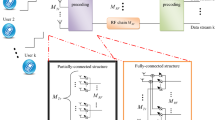Abstract
Femtocells are the feasible solutions to extend the network coverage of indoor users and to enhance the network capacity in long-term evolution advanced (LTE-A)-based 5G networks. However, the femtocell base station shares the same frequency spectrum of microcell base station in unplanned manner. Hence, interference mitigation is a crucial problem in densely deployed femtocell environment and it is more severe with the deployment of femtocells in LTE-A network. In this paper, a modified dirty paper coding is proposed for interference mitigation along with the optimization of feedback bits using natural inspired meta-heuristic firefly algorithm. The proposed meta-heuristic algorithm reduces the interference by periodically unicasting the channel state information. Since the bandwidth of feedback system is limited, it is optimized in such a way that it does not affect the performance of the system. As compared to the conventional zero-forcing pre-coding, the proposed modified dirty paper coding along with firefly algorithm scheme offers improved sum rate of 70% and 64% with increase in the number of feedback bits and number of users, respectively.








Similar content being viewed by others
References
Baccarelli E, Cordeschi N, Mei A, Panella M, Shojafar M, Stefa J (2016) Energy-efficient dynamic traffic offloading and reconfiguration of networked datacenters for big data stream mobile computing: review, challenges, and a case study. IEEE Netw 30(2):54–61
Bagaria J, Shahnasser H (2015) Meeting challenges of LTE advanced through small cell deployment. J Adv Comput Netw 3(3):230–234
Chandrasekhar V, Andrews JG, Gatherer A (2008) Femtocell network: a survey. IEEE Commun Mag 46:59–67
Chikte K, Rajesh A (2016) Performance analysis of an improved CSI feedback technique for LTE-A system with femtocell interference. In: 2016 IEEE international conference on engineering and technology (ICETECH)
Deng W, Zhao H, Yang X, Xiong J, Sun M, Li B (2017) Study on an improved adaptive PSO algorithm for solving multi-objective gate assignment. Appl Soft Comput 59:288–302
Deng W, Xu J, Zhao H (2019) An improved ant colony optimization algorithm based on hybrid strategies for scheduling problem. IEEE Access 7:20281–20292
Elsherif AR, Ahmedin A, Ding Z, Liu X (2012) Adaptive precoding for femtocell interference mitigation. In: IEEE international conference on communication (ICC), pp 4315–4320
Golaup A, Mustapha M, Patanapongipibul LB (2009) Femtocell access control strategy in UMTS and LTE. IEEE Commun Mag 47(9):117–123
Guruacharya S, Niyato D, Hossain E, Kim DI (2010) Hierarchical competition in femtocell-based cellular networks. In: Proceedings of IEEE Globecom’10, pp 1–5
Jeon Y-S, Kim YJ, Min M, Im G-H (2014) Distributed block diagonalization with selective zero forcing for multi-cell MU-MIMO systems. IEEE Signal Process Lett 21(5):605–609
Kim T, Lee T (2008) Throughput enhancement of macro and femto networks by frequency reuse and pilot sensing. In: Proceedings of IEEE international performance, computing and communications conference (IPCCC), pp 390–394
Kim D, Shin O-S, Bok K (2012) Channel feedback optimization for network MIMO systems. IEEE Trans Veh Technol 61(7):3315–3321
Li H, Xu X, Hu D, Qu X, Tao X, Zhang P (2010) Graph method based clustering strategy for femtocell interference management and spectrum efficiency improvement. In: Proceedings of IEEE 6th international conference on wireless communications networking and mobile computing (WiCOM), pp 1–5
Lin P, Zhang J, Chen Y, Zhang Q (2011) Macro-femto heterogeneous network deployment and management: from business model to technical solutions. IEEE Trans Wirel Commun 18(3):64–70
Moon SH, Lee SR, Kim JS, Lee I (2014) “Channel quantization for block diagonalization with limited feedback in multiuser MIMO downlink channel. J Commun Netw 16(1):1–9
Pantisano F, Bennis M, Saad W, Debbah M (2011) Cooperative interference alignment in femtocell network. In: IEEE global telecommunication conference (GLOBECOM 2011), pp 1–6
Ravindran N, Jindal N (2012) Multi-user diversity vs. accurate channel state information in MIMO downlink channels. IEEE Trans Wirel Commun 11(9):3037–3046
Sahin ME, Guvenc I, Jeong M-R, Arslan H (2009) Handling CCI and ICI in OFDMA femtocell networks through frequency scheduling. IEEE Trans Consum Electron 55(4):1936–1944
Saquib N, Hossain E, Le LB, Kim DI (2012) Interference management in OFDMA femtocell networks: issues and approaches. IEEE Wirel Commun 19(3):86–95
Sivaraj N, Palanisamy P (2015) Downlink interference analysis in LTE-femtocell network. J Netw 10(5):294–301
Tan L, Feng Z, Li W, Jing Z, Gulliver TA (2011) Graph coloring based spectrum allocation for femtocell downlink interference mitigation. In: Proceeding of IEEE wireless communication on networks conference (WCNC2010), pp 1248–1252
Widiarti H, Pyun S, Cho D (2010) Interference mitigation based on femtocells grouping in low duty operation. In: Proceedings of IEEE 72nd vehicular technology conference fall (VTC’10-fall), pp 1–5
Zhang L, Yang L, Yang T (2010) Cognitive interference management for LTE-A femtocells with distributed carrier selection. In: Proceedings of IEEE 72nd vehicular technology conference fall (VTC 2010-fall), pp 1–5
Zhao H, Zheng J, Deng W, Song Y (2020) Semi-supervised broad learning system based on manifold regularization and broad network. IEEE Trans Circ Syst 67(3):1–12
Funding
This study was not funded by any organizations.
Author information
Authors and Affiliations
Corresponding author
Ethics declarations
Conflict of interest
The authors declare that they have no conflict of interest.
Ethical approval
This article does not contain any studies with human participants or animals performed by any of the authors.
Additional information
Communicated by V. Loia.
Publisher's Note
Springer Nature remains neutral with regard to jurisdictional claims in published maps and institutional affiliations.
Rights and permissions
About this article
Cite this article
Hariharan, S., Chikte, K., Shankar, T. et al. Optimization of feedback bits using firefly algorithm for interference reduction in LTE femtocell networks. Soft Comput 24, 15361–15371 (2020). https://doi.org/10.1007/s00500-020-04871-2
Published:
Issue Date:
DOI: https://doi.org/10.1007/s00500-020-04871-2




